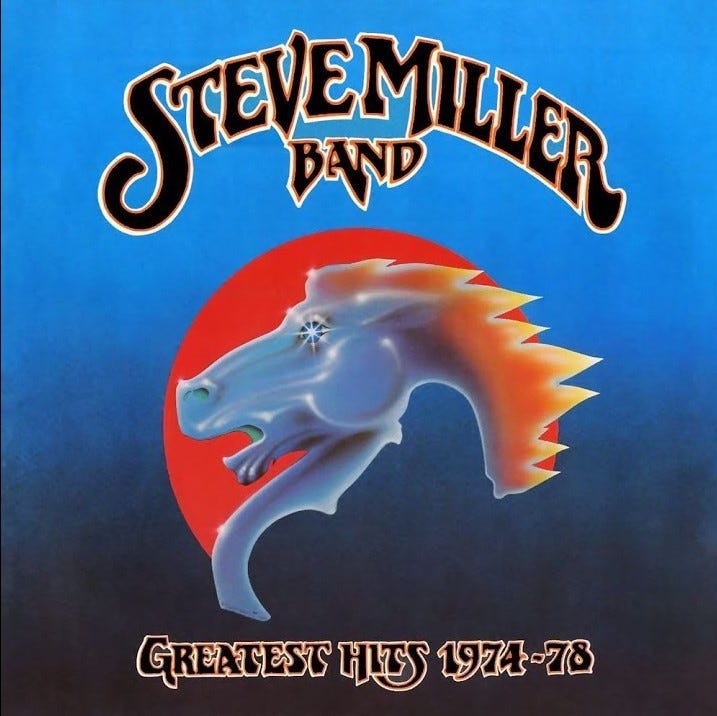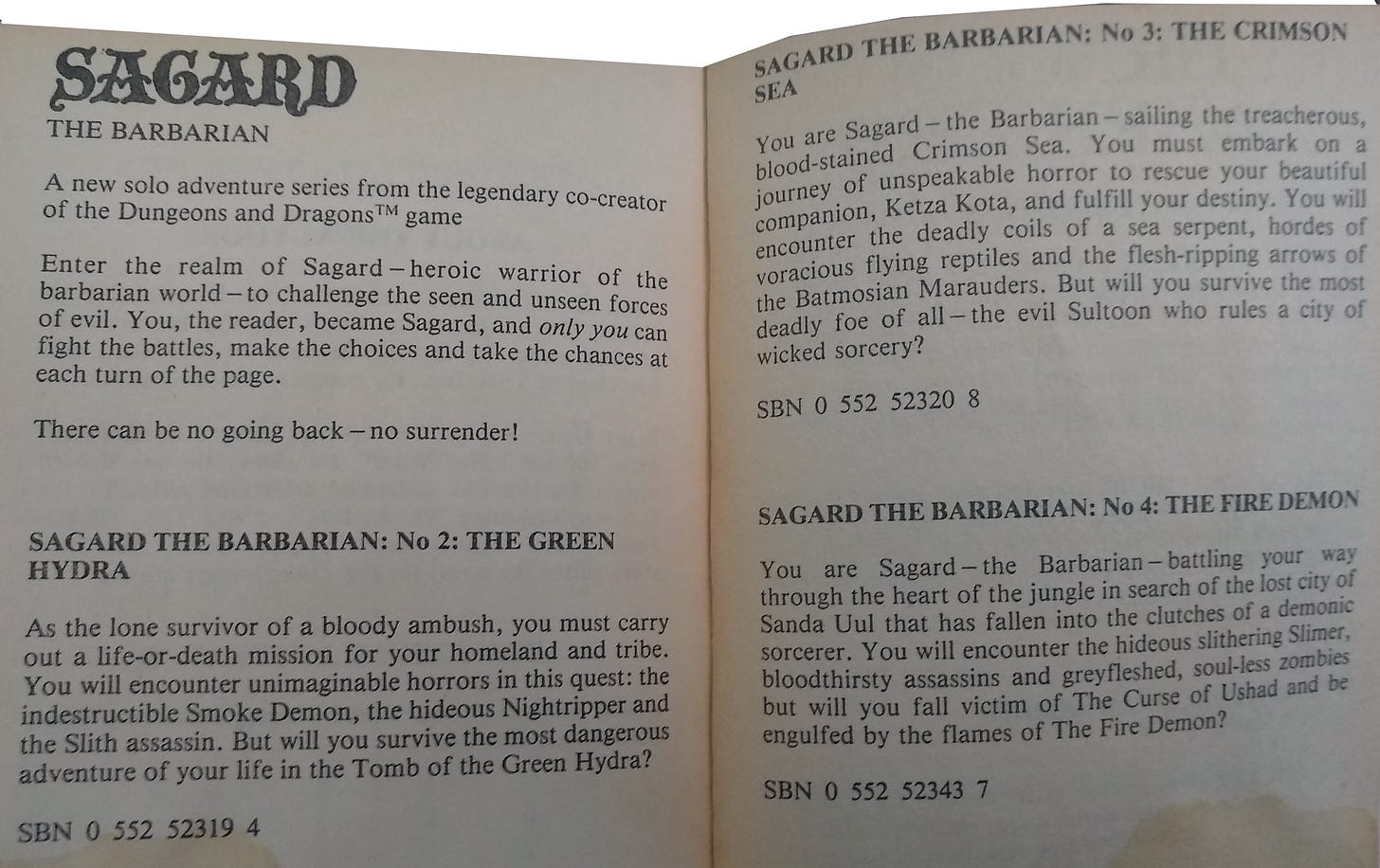Barbarians Just Want To Be Accepted For Who They Are
“The Elder looks at you and trembles slightly. ‘Never before, except in tales from the forgotten past, has one so young brought back so much. One day, Sagard, your name may be known throughout the Flanaess of all Oerth. It is with humble respect that I turn over the chieftanship of the tribe to you.’”
That’s how my gamebook session could’ve ended . . .
Instead, I was sort of begrudgingly accepted into the tribe by not earning the highest number of Trophy Points - oh well. Something to aim for next time so my name could be known over whatever a “Flanaess” is.
Sagard The Barbarian is a series of gamebooks created back in the 80s by none other than Gary Gygax (the co-creator of Dungeons & Dragons) and Flint Dille (screenwriter for An American Tail: Fievel Goes West, and The Transformers: The Movie, and involved with G.I. Joe, Transformers, Mr. T and the T-Force, Robo Force, The Garbage Pail Kids, Visionaries, Bigfoot and the Muscle Machines, and Inhumanoids kids cartoons as well as the Pokémon Go game).

This Hero’s Challenge series recently came to my attention during an eBay treasure hunt - I don’t ever recall seeing them as a kid.
During the hunt, Book 1 “The Ice Dragon” was a bit more than I wanted to pay at the time, but I found a good bargain on Book 2 “The Green Hydra” so went with that one instead.
Starting at Book 2 just didn’t feel right though - and besides, in the very 1st battle, the footnote brought on a repressed bout of barbarian weapon envy in me:
“If you gained a sword in the first book, retain the benefits of it. If not, then you are using a regular sword and it will have no effect on combat.”
Brilliant marketing on their part. Who doesn’t want an italicized sword?!
Who wants just a plain ol’ “regular sword” with “no effect on combat”?
Not this barbarian.
So, I sought the Ice Dragon of Oerth from my office here on Earth.
I have to say, it was a really fun read. The narrative kept your choices in character by the big (or reduced) rewards you would receive by following the unspoken code of your barbarian tribe.
“You only receive 1 experience mark for this fight, and you do not heal any wounds. You have learned something important about the ways of a warrior. Sagard shall never fight for the amusement of anyone. In a later book, this knowledge shall come in handy.”
Yeah, I totally learned that lesson . . . twice.
BTW, I only perished 1.5 times (I didn’t want to start over from the beginning the 2nd time, so took a little liberty and re-rolled the battle - Shhhh!)
Game Mechanics:
I found the gaming mechanics pretty unique and fun. The instructions aren’t at the beginning like many gamebooks - you start in media res, and only when the first battle occurs are you directed towards them, which are short and to the point.
As an adult, I’m a big fan of simplified rulesets in my gamebooks, as I like to get more into the flow of the story than be bogged down by too much strategy.
(Featuring artwork from Clyde Caldwell & Luke Eidenschink!)
Hero’s Challenge uses a d4 (4-sided dice) for everything - or if you don’t have or want to use dice, they put circled numbers in the top corners of all the pages, so a quick blind flip will get you your result.
UPDATE: After I posted this article, I found Flint Dille’s memoir called, “The Gamesmaster: Almost Famous In The Geek ‘80s” and have been devouring it.
I discovered several interesting references to Sagard’s creation that I didn’t find anywhere else:
Flint chose a d4 because he thought they looked cool. Also, you could skip the dice and use 2 coins instead.
He based Sagard’s point of view on Gary Gygax’s son, Luke, who was 13 at the time.
The story of how they came to the name “Sagard” is as follows: They had to sign the contract, but needed a name and Gary was just about to leave on a trip. Flint considered Sagard sort of a Nordic hero and always liked the name “Asgard”. After a couple letter swaps, you get “Sagard”!
In these books there are only 3 Fighting results. You either Win, Lose, or (attempt to) Flee.
Combat results are determined by yours and your opponent's level (0-5) with a simple embedded combat charts for every battle.
You always get to go first. If you’re level 2, and you roll a 1 - no damage to your opponent. Their turn. They are level 1 and roll a 3, they do 1 point of damage to you. Track each other’s Hit Points, and follow the prompts. As simple as that.
Other results & effects are determined by odd or even numbers or even a flip of the coin. Just be aware, there are plenty of encounters that won’t allow you to attempt to flee. (“I’m looking at you, Frusti Sage!”)
Other mechanics include gaining Experience Marks which can increase your level (and enhance your fighting level chart), collecting Trophies to prove your worth to your tribe, Finding enhanced Weapons & Armor to ease your battle burdens, and Acquiring Special Items with ooh, special powers! Keep track of it all on your Sagard Status Chart.
Pretty cool.
Oh, and don’t think you can outsmart the authors on your second time through.
After dying and losing a really awesome piece of equipment that had been rewarded to me right before that battle, I figured I’d just flee from them the second time around. Why not? I already had the item, right?
Well . . .
After a successful flee roll avoiding my enemies’ grabby hands, I was like, “YES! This is MINE now. Hahahahaha!” Then I flipped to the directed page.
“You dash away from the onrushing [enemies]. At first, the chase is tight, but removing the [equipment] greatly increases your speed. Take the [equipment] off your status chart . . .” (names in brackets to not give away spoilers)
Ugh. There’s ANOTHER lesson this harsh barbarian world taught me.
There are a bunch of battles where you are fighting multiple opponents at the same time. Sometimes you are given a choice on how you would like to engage them with different advantages. It definitely upped my emotional involvement when fighting things like 15 simultaneous 1-hit-point-bats. It also upped how many dozens of rolls I had to make . . . my rolling arm is still sore, but recovering, thanks for asking.
Oh, and you get to carry your Experience Marks and Weapons and Armor with you to subsequent books!
Beyond the mechanics, the storyline was fun, and even had some pun-type names of opponents that you will totally “get” once you reach the huge twist near the end (no spoilers here. It’s against my newfound barbarian code - Also, I don’t want my equipment taken away from me again.)
There were 4 books total for Sagard, all published between 1985-1986 with different covers between the UK and US versions:
Book 1: The Ice Dragon
Book 2: The Green Hydra
Book 3: The Crimson Sea
Book 4: The Fire Demon
Oh, and I didn’t realize, since it wasn’t explicitly stated, but Sagard’s adventures actually take place in the world of Greyhawk, one of the original and most famous D&D settings!
The Cover Artwork:


In the US, Richard Corben did books 1 and 2, while James Warhola did books 3 and 4.


All of the UK (Corgi) editions were done by Gino D’Achille - uncredited for some reason.




Richard Corben (1940-2020) was an American Illustrator and comic book artist best known for his comics featured in Heavy Metal Magazine.
I wrote more about Richard in my article “The Forest of Doom - 40 Years of Fighting Fantasy Fun” here:
James Warhola is another American artist famous for science fiction and fantasy art as well as children’s books and Mad Magazine illustrations. James is one of the original artists of the Garbage Pail Kids, and he illustrated over 300 science fiction book jacket covers, including Stranger in a Strange Land (Robert Heinlein) and Neuromancer (William Gibson). Oh, and he is also Andy Warhol’s nephew!
Gino D’Achille (1935-2017) was an Italian Sword & Sorcery artist popular for his work on the Gor book series as well as some Edgar Rice Burrough’s Barsoom series. His work included 1950s film posters and illustrations for the Bible, Sherlock Holmes stories, The Jungle Book, Fu Manchu stories, Arthurian legends, Edgar Rice Burrows’s John Carter of Mars series and the Jack Vance Science Fantasy series as well as stories by Daphne du Maurier and Mary Stewart.
Here’s an article I found online that talks about him and shows several of his book covers: http://www.castaliahouse.com/forgotten-sword-and-sorcery-artists-gino-dachille/
The Interior Artwork:
Leslie Morrill did the internal illustrations for books 1-3, while Iain McCaig did book 4. I don’t own book 4 yet, so don’t have any of Ian’s work to show here. I’ll have to update this article when I do. I sure do like Leslie’s work though!
Leslie Morrill (1934-2003) was a designer and award-winning illustrator for many children’s books from the 70s, 80s and 90s, including many from the Choose Your Own Adventure series. His work appears in more than 100 books and was especially well-know for his animal illustrations.
I couldn’t find a lot of information on Leslie, but was surprised to see he had even done the illustrations for the popular “Bunnicula” series!
https://biography.jrank.org/pages/135/Morrill-Leslie-H-olt-1934-2003.html
Iain McCaig is a crazy-accomplished creator, artist, writer, filmmaker and illustrator. His credits are insane (Terminator 2, Star Wars, Harry Potter, The Avengers, just to name a few).
I wrote a bigger section about Iain in my article “The Forest of Doom - 40 Years of Fighting Fantasy Fun”, here:
Well, this has been fun, but Sagard Book 2 is calling to me. Now that I have the fabled italicized sword, I can’t help but wonder how many fewer barbarian lessons I will have my nose rubbed in on this next adventure . . . and of course how accepting the Elders will be of my next trophy haul.
I mean, why can’t they just accept me for who I am? Can’t they see that I’m more than just a hunky man-meat muscled courier? That I can do more than simply feed their dirty trophy habit addiction. I just want to be me. What do they do with all those trophies anyway?
Oh well. I’m off to earn their love and my keep, because as they told me in MY ending to Book 1:
“Sagard, we have looked at your trophies. Some have done better, most have done worse. One day you might be a great warrior, but you still have much to learn.”





















Nice memory.
I had book 4 (probably from Scolastic) and found it decent. Gary Gygax does Conan. As an adult, I later went back and read the others. This one has its charm.